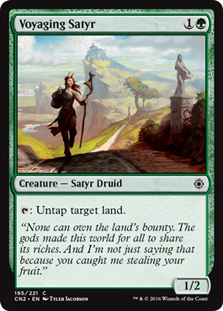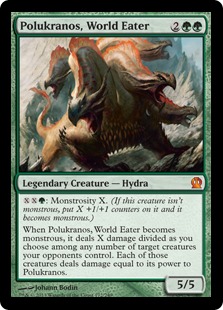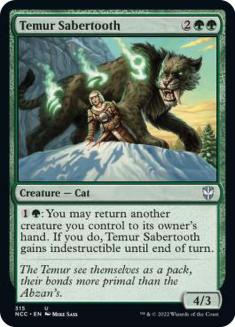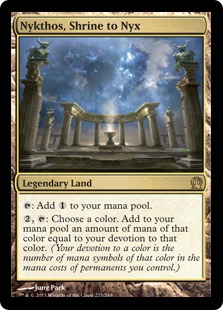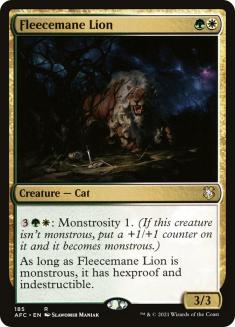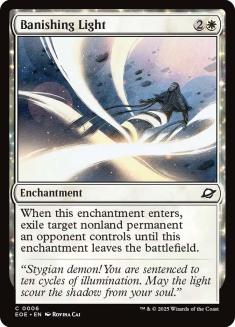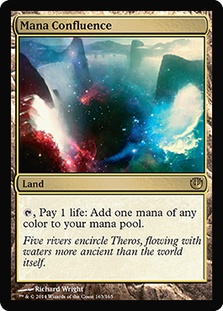I like to think that I give pretty good deck selection advice. Before Grand Prix Miami though, I definitely messed up. I gave good advice, but I didn’t
give great advice.
My friend Matt Sperling was asking people what he should play for Miami, and I suggested to him, without hesitation, that he should play my U/B Control
deck. At the same time, another of our teammates, Sam Black, was heartily suggesting the G/W Devotion deck. Matt had reasons to be interested in both
decks, and I strongly recommended the one I knew. The results of Memphis made me feel as though Abzan Midrange would be the pivot-point of Miami, and that
felt good to me for my deck.
By “pivot-point,” what I mean is that the decisions of players entering the event would turn on their decisions regarding Abzan Midrange. There would
likely be a large number of players that would choose to play Abzan Midrange and likely another large number of players that would chose to play to beat Abzan Midrange. Of these two strategies, copying the winning strategy tends to be the more successful, since, in general, ‘best decks’ are
not alone in a format, and trying to both beat a top deck and do well in a wide metagame requires a very careful balancing in deck construction.
In addition, I thought U/B Control was just well-positioned against the two other notable decks from Memphis, Sultai Control and R/W Aggro, as well as
being strong against many other decks in the field. Piloting it though, is a difficult proposition. There are so many ways to lose a winning game, U/B
Control isn’t exactly a deck you’d be likely to call “forgiving“.
Now, in the aftermath, it is obvious that G/W Devotion was absolutely and utterly the deck to play in the event. Not only did two different
groups’ version of the deck make the top 8, but they could only be beaten by each other. Fellow Madisonian Daniel Cecchetti took the tournament down after
being handed the deck that weekend! That’s a pretty remarkable thing.
Sperling, for his part, ended up making the right call, G/W Devotion, but it wasn’t until the event was underway that I realized how great a call it was
for the event. When it came to Memphis, in retrospect, I still think U/B Control was the right call for the event (and but for a mistake, I feel like I was
on the path to a potential top 8), but when it came to Miami, even though U/B Control was a great deck, I don’t think it would have been the right
call.
Here’s how I came to that incorrect conclusion.
The Lure of U/B Control
I’ve been winning a lot with this deck, and it requalified me for the
Pro Tour. Something as simple as that can be enough to keep you excited about a deck, regardless of whether it is still well-positioned.
One of the biggest appeals of U/B Control right now is that the combination of removal, countermagic, and card advantage is incredibly powerful. Mixing
metaphors, other than Abzan Midrange, there are very few decks that have much in the way of gas if you take the wind out of their sails. If you can
suppress the initial rush of a deck in Standard, it is very rare that they can get back in the game. Every time that they draw a land, it is dead, and
every time you do, it is another valuable resource. With a clear board (or virtually clear board in the case of a minor annoyance in play facing off
against a Perilous Vault), every time you draw a Dissolve or Hero’s Downfall, it is like you’re buying yourself yet more card draws to further lock the
other person out. (Old school players might think of this as similar to having a ton of copies of Gush in your Stasis deck.)
With so few decks actually having any card advantage from non-permanents, keeping alive until you can clear the table with a Perilous Vault or Ugin, the
Spirit Dragon can usually mean the ending is inevitable so long as you don’t do anything truly foolish. A big part of the reason that the worst matchups
(Mono-Red Aggro, R/G Aggro, W/U Heroic, Temur) are so problematic is that they can kill you before you get to that point, and in the case of the decks with
red, they can even kill you after with a timely burn spell.
The majority of the metagame is just well-suited to what this deck wants to be doing. This is a huge part of why I was recommending it to people for Miami.
Here is the list I played in Memphis (and would have played in Miami):
Planeswalkers (5)
Lands (27)
Spells (28)

So, I’ve talked about what makes this deck appealing. But what about it is not appealing?
I started out winning a great deal with this deck before Fate Reforged. Then, after Fate Reforged came out, I spent a lot of time losing. A lot.
I’m certain I know what it was too. U/B Control is not a very forgiving deck – if you mess up, it will punish you for it. The format had just grown a great
deal, and I hadn’t yet adapted to it. But there is also another, more structural problem that influenced my poor results, something I touched upon in my
article “Forgiveness” many years
ago:
“Unforgiving decks
[…] can be incredibly powerful, but they do tend to get weaker as card pools get bigger or as the opposition decks get more honed […]
In smaller card pools or less defined formats, you won’t need to have as forgiving a deck because the relative punishment you might get for messing up
or having a bad draw is less huge, but with each successive week or card set that goes by, you’ll want to make your decks more and more forgiving.”
Bigger pools provide a bigger wallop for any deck you might play against. The more time a format develops, people not only get better with the decks that
they might play against you, but the decks themselves get better overall. An aggressive deck early on with less sets in the mix is simply less able to dole
out punishment than it can when an extra set or two are out. Even if an unforgiving deck is getting new weapons as well, if it is still unforgiving, you
end up on a tightrope where you’re required to play perfectly.
I feel like my build of U/B Control is one of the most powerful decks in Standard. But it is not a forgiving deck. This last weekend, I did fairly
poorly at a $5K in Chicago, running the exact same 75 I took to GP Memphis. The big difference between my experiences at the two events was simple: in
Chicago, my head wasn’t in the game, and it cost me.
After Memphis, I’d been sick. I was sick enough that I spent most of the next ten days after Memphis in bed. The night before the event, there’d been a
shooting a block from my house, and between that and the protests that went on until the wee hours of the morning, I ended up without much sleep. I was
just wiped, and with each passing match, I felt more drained. Pretty quickly I had two losses, both of which should have been wins had I not messed them
up.
My friend and teammate Andrew Baeckstrom played the same 75, in part because of my hearty recommendation of the deck, and in part because he wanted to get
some practice in. He ended up finishing in the Top 32, but he definitely made note that many of his lost games were games he should have won.
That is not to say that the deck should win every match if played properly. It is more about the deck, when properly piloted, really seems to be
near the top of what I perceived the metagame to be. That was the case, even having access to Sam’s decklist going into Miami.
Well, that was wrong.
The Positioning of G/W Devotion
Before the event, Sam said, “I don’t often claim decks are this good.”
Well, it wasn’t that I didn’t believe Sam when he said that it was a good deck; it was more that I didn’t see how the deck could be that different than,
say, G/R Devotion. Here is the list Daniel Cecchetti took to the championship in Miami:
Creatures (31)
- 4 Elvish Mystic
- 4 Polukranos, World Eater
- 4 Sylvan Caryatid
- 2 Fleecemane Lion
- 4 Voyaging Satyr
- 4 Courser of Kruphix
- 4 Genesis Hydra
- 4 Whisperwood Elemental
- 1 Temur Sabertooth
Lands (24)
Spells (5)

Now, of course, I understood the fundamental difference between Sam’s list and G/R builds; Mastery of the Unseen was a card I’d been interested in right
from the beginning of the set, and I fundamentally respected G/X Devotion shells.
Where I made my mistake was looking at the field of play wrong.
I was looking at the metagame purely from the perspective of U/B Control. I knew that the deck was powerful and well-positioned, and so, when I thought
about Sam’s deck, I didn’t think about the metagame from the perspective of Sam’s deck at all. Instead of thinking about what the differences between G/W
and G/R Devotion meant and how the deck was positioned, I thought about the similarities of the two decks, and then just thought about how I didn’t see the
deck as particularly scary for my deck.
This is not the right attitude to take.
The maindeck’s piloted by Daniel Cecchetti and Corey Baumeister have a lot in common. If you want to take Cecchetti’s build and change it to Baumeister’s,
you’d only have to do the following:
Out:
In:
The sideboard is much more wildly different, but their hearts are the same. In comparison to other devotion lists, the key card in this list, Mastery of
the Unseen, allows something quite spectacular. It isn’t just that the card adds more resiliency to the deck, it’s that it also adds inevitability
.
A Crater’s Claws or a Xenagos, the Reveler are both fully capable of closing out a game. Crater’s Claws can only really do so though, when an opponent has
already spent much of the game under duress, or when mana production elements of the deck have really worked out. In addition, Crater’s Claws is yet
another card that a Hydra can’t do much with. Xenagos can do wonders in putting pressure on in a game, but later on, it can end up being a little anemic.
Being resilient means that the deck can actually stand toe-to-toe with a midrange control deck like Abzan Midrange and be able match Abzan in terms of
cards and present a lategame that is likely impossible for Abzan to overcome. When a game is going long, Mastery of the Unseen not only provides
more card advantage but more life as well, making that card advantage be all the more relevant.
Looking at how this deck lines up against any number of decks, it is a fundamentally overwhelming midrange deck. No control deck that isn’t specifically
well-positioned (by happenstance before Miami, by choice after) could hope to resist the persistence of this deck’s long game. Any aggressive deck would
have to be able to close out games before Mastery of the Unseen turned everything around via a relentless creation of lifegain triggers. Other midrange
decks were especially hard hit, with their plan fundamentally based on ruling the board facing up against a deck that could not only gum up the board
phenomenally well but probably do it better than anything the other deck could hope to manage.
While the deck certainly has a weakness to flying attackers, there was no reason going into Miami, to expect a huge amount of that strategy. The most
likely decks to see were going to be decks based on the winners from Memphis (Abzan Midrange, Sultai Control, and R/W Aggro) and the decks that beat them.
In this world, G/W Devotion was a spectacular deck choice.
One final aside on the specifics of the list Cecchetti played: I really like the card counts. This deck is four-of nearly everything, maximizing all of the
things you just want to see happening. One Banishing Light is something you can find in game 1 to solve a problem. One Temur Sabertooth, while certainly
great in the mirror, is simply great in any situation where a game can go to the infinite time horizon. Finally, the two Fleecemane Lion are
simply the nod to the deck’s need for defenses against more aggressive decks, filling up the deck after the proper amount of land and the proper amount of
spells have had their space. This concession to defense against an aggressive opponent is a great call, and the other two Fleecemane are there in the board
for when you need them, leaving the maindeck completely full of four-ofs for everything you want to be doing.
Moving forward, G/W Devotion is going to have a huge target painted on its head. Dragons of Tarkir won’t be legal until the Season One Invitational in
Richmond at the end of the month. Until then, I’d study up on Sam’s article about the future of G/W Devotion, because
even if the deck might not live through Dragons of Tarkir, there is still plenty of Magic to be played until then!
I expect I’ll be continuing forward with U/B Control. I’m still trying to figure out if the brave new world we have for the next few weeks requires that
fourth Perilous Vault or not. I’ll be sure to let you know.


